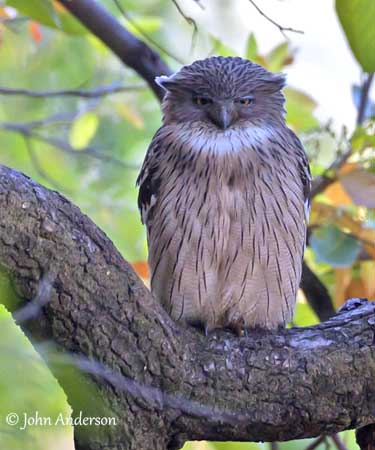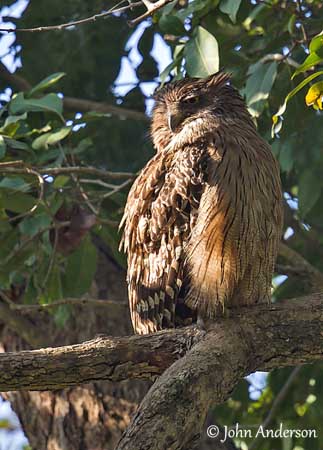
DIET:
The Brown Fish-Owl feeds mainly on aquatic preys such as fish, amphibians and crustaceans. Snakes and lizards are also taken and occasionally large insects, rodents and birds. Some observations report this owl feeding on carrion too.
It hunts from perch ad swoops down onto the prey.
PROTECTION / THREATS / STATUS:
The Brown Fish-Owl appears more numerous in Sri Lanka. The species is generally uncommon or local throughout the rest of its range.
It is probably extinct in several regions of Middle East, due to poisoning of rodents by agriculture chemicals, drainage of swamps and pollution of rivers.
This species is not currently globally threatened.
Fr: Kétoupa brun
All : Fischuhu
Esp: Búho Pescador de Ceilán
Ital: Gufo pescatore bruno
Nd: Bruine Visuil
Sd: Brun fiskuv
Photographer:
John Anderson
John Anderson Photo Galleries
Alan & Ann Tate
AA Bird Photography
Text by Nicole Bouglouan
Sources:
HANDBOOK OF THE BIRDS OF THE WORLD Vol 5 by Josep del Hoyo-Andrew Elliott-Jordi Sargatal - Lynx Edicions - ISBN: 8487334253
HANDBOOK OF THE BIRDS OF INDIA AND PAKISTAN – vol 3 – By Salim Ali and Dillon Ripley – OXFORD UNIVERSITY PRESS – ISBN: 195613023
OWLS OF THE WORLD – By Claus König, Friedhelm Weick and Jan-Hendrik Becking - IBSN 978-0-7136-6548-2
A photographic guide to Birds of Vietnam, Cambodia and Laos by Peter Davidson. New Holland Publishers. ISBN: 9781847731418
A Field Guide to the Birds of South-East Asia by Craig Robson. New Holland Publishers. ISBN: 9781780090498
BirdLife International (BirdLife International)
Article: Fish-owls
Brown Fish-Owl
Ketupa zeylonensis
Strigiforme Order – Strigidae Family
BIOMETRICS:
Length: 50-57 cm
Weight: 1100 g
DESCRIPTION:
The Brown Fish-Owl is the most widespread in the region. It is nocturnal, but it may easily flush from its daytime roost.
The adult of race K.z. leschenault here displayed has warm buffish-brown colour with conspicuous blackish-brown streaks on crown and upperparts. On the upperwing, the dark brown wing-coverts and the flight feathers are mottled whitish-buff. Scapulars and bib are streaked whitish. The tail is barred brown and buff.
The underparts are buffish-white with long dark brown streaks and thin pale rufous cross-lines.
Like in other Ketupa species, tarsi are unfeathered.
On the head, the crown is mostly flat with conspicuous horizontal, floppy ear-tufts. Facial disc is buff with dark upper cheek.
The bill is greenish-grey with darker tip. The eyes are golden yellow to bright yellow. Legs and feet are yellowish. Toes are equipped with spiny scales on the underside, to grip the slippery fish.

Both sexes are similar.
The juvenile has paler wings, and pale creamy-buff body and head with long dark brown streaks.
There are four subspecies:
K.z. semenowi occurs in S Turkey and N Syria to NW India. This race is very pale but brighter coloured.
K.z. leschenault (here described and displayed) is found in India (S of Himalayas), E to Myanmar (except NE) and Thailand.
K.z. zeylonensis - The nominate race occurs in Sri Lanka. It is smaller and darker than “leschenault”.
K.z. orientalis is found in NE Myanmar to SE China, S to Malay Peninsula, Indochina and Hainan Island. This race is darker with more black on the upperparts, and stronger buff underparts.
VOICE: SOUNDS BY XENO-CANTO
The Brown Fish-Owl gives deep, rapid, hollow “HU WHO-hu” or “HUP-HUP-hu” as territorial calls. The last note is barely audible.
We can also hear a deep booming “hOOo BOOOOo-hOOo”, and a mournful scream.
This species also produces series of deep mutterings ending and rising to maniacal laughter “hu-hu-hu-hu-hu ha-ha” or “oof uh-oof uh-oof uh-oof uh-oof uh-oof u-uh-h-HA-oo-oo-oof”

The Brown Fish-Owl hunts from perch, watching for preys over water, pool or stream. Once the prey is detected, it swoops down with dangling legs above water and catches the prey with the talons.
It also flies up and down and sometimes appears almost skimming the water. Aquatic preys such as fish are taken from near the surface. It may wades in shallow water for preys too.
Courtship behaviour is little known, but courtship feeding probably occurs like in most Strigidae species.
They are solitary and usually occur in mated pairs. Resident species such as the Brown Fish-Owl tend to be highly territorial all year round, and maintain the nesting-site.
Both mates may frequently duet at the beginning of the breeding season. The female replies sometimes before the end of the male’s call, but usually she starts immediately after this call.
They are solitary and usually occur in mated pairs. Resident species such as the Brown Fish-Owl tend to be highly territorial all year round, and maintain the nesting-site.
Both mates may frequently duet at the beginning of the breeding season. The female replies sometimes before the end of the male’s call, but usually she starts immediately after this call.
FLIGHT:
The Brown Fish-Owl has less silent flight than all Strigidae species, because it lacks the soft fringes on primary feathers. It is a good flier, whether in open habitats or in dense forests and woodlands.
REPRODUCTION:
The breeding season varies according to the range.
The Brown Fish-Owl breeds in dry monsoon season, when water levels are low, making easier to locate the aquatic preys.
It nests in hollow in tree, or in other suitable depression in tree too. It may use an abandoned raptor nest, or establish the nest-site on rock ledge or steep river bank. The nest is usually placed between 4 and 21 metres above the ground, sometimes more, up to 30 metres, and almost always near water.
The female lays 1-3 creamy-white eggs, and incubates during 34-38 days. She is probably fed by the male during this period. The young are fed by both parents, and fledge about 50 days after hatching.

HABITAT:
The Brown Fish-Owl frequents various types of forests almost always near slow-moving streams. It can be found in old plantations, groves with mature trees, steep banks and canalsides.
According to the range, the species is visible from 600 metres up to 1900 metres in China, from plains up to 800 metres in Thailand, and usually between lowlands and foothills and 1500 metres of elevation.
RANGE:
See above in “subspecies”
BEHAVIOUR:
The Brown Fish-Owl feeds primarily on fish, frogs and freshwater crabs. Other prey items such as crayfish, snakes and lizards are taken. It may occasionally catch rodents, birds and large insects, and sometimes carrion.
This species is more often crepuscular and nocturnal, but it can be seen by day too, flushing from its daytime roost, especially in cloudy weather.